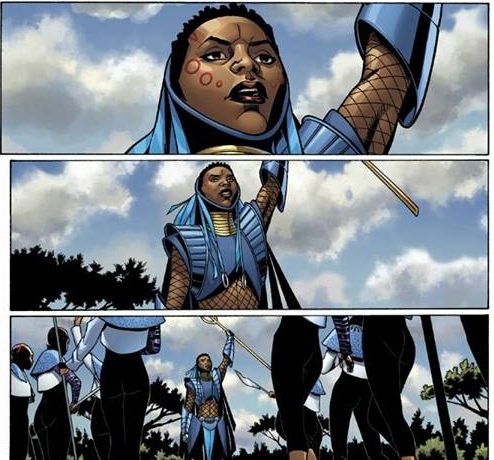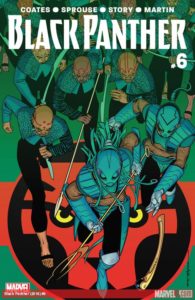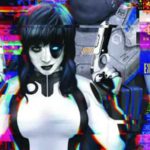
Black Panther #6 Review
Writer: Ta-Nehisi Coates
Artists: Chris Sprouse
Colorists: Laura Martin
Inker: Karl Story
Letterer: JC’s Joe Sabino
Editors: Wil Moss
Publisher: Marvel
 Coates, on his twitter feed, talks long and often about Black Panther. He calls the first 12 episodes a season and this feels appropriate because each issue is about as dense as an hour of the finest T.V. drama.
Coates, on his twitter feed, talks long and often about Black Panther. He calls the first 12 episodes a season and this feels appropriate because each issue is about as dense as an hour of the finest T.V. drama.
This issue picks up after some devastating propaganda has been released about T’Challa and some of his methods in issue five. It sets off this cataclysmic series of events that you wonder how Black Panther will ever come back from.
One interesting dynamic that Coates and Company hit on is that T’Challa isn’t just the political ruler of Wakanda, he is also the religious leader. Political insurrection against the state (and as a monarchy, him) isn’t just revolution, it makes one a heretic. This has been inferred in other comics about Black Panther, but never has it been so boldly stated. In terms of intelligence, Black Panther is one of the smartest people in the Marvel Universe. He understands the broad base appeal of Democracy. But as T’Challa says, “My Blood is my name” and you know that T’Challa will fight tooth and nail to ensure that the monarchy continues in Wakanda.
As an American reader we are taught that democracy = right/justice/fairness. As such, to read a book where the titular character supports a monarchy would almost de facto make him the ‘bad guy’. What is the reader to do? Coates creates a moral dilemma for the reader and it these narrative conceits that make the book so interesting to me.
Coates narrative is strong, but so is the storytelling by Chris Sprouse. On the third page of the comic is some wonderful storytelling. The Hatut Zeraze (Dogs of War) are about to attack the Midnight Angels. The reader is given a wonderful close up of the face of Aneka. She is given a rousing speech to the women she has freed from the unmerciful hands of their fellow countrymen. Slowly, Sprouse zooms the camera out from one woman to many women. Then the woman getting prepared for war and the last panel is the Dogs of war on four planes coming in to execute their King’s order. These five panels illustrate to the reader that the Midnight Angels have become a powerful faction and that they have trained a prepared for this day. Aneka and Ayo have molded these women into something that once were “bred solely to give {their} bodies” into a force to be reckoned with.
As much personality that Coates and Sprouse give to the comic, the same can be said of Laura Martin. The portion of the comic with Shuri in the Djalia has some wonderful color work where the color actually shows the passage of time. It goes from blue, to purple, to orange and finally to green. This is the page with the panel stacking talking about the slave girl. The content matter is deplorable, but the rendering is beautiful. There is another page in the same section where there are no panel borders but through the use of shadows the reader is able to transition. Subtle touches like that make this book transcendent.
Verdict:
Must BUY! I go to the comic shop every week and over hear people that detest this Black Panther. This book isn’t for everybody, it is dense and it doesn’t baby the reader. However, if you’re into a comic book that is building the foundation for a culture of Wakanda this book is for you.



![[REVIEW] MARVEL ZOMBIES: RED BAND #1](https://geekd-out.com/wp-content/uploads/2025/09/mzrb1-feat-150x150.jpg)